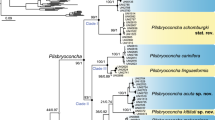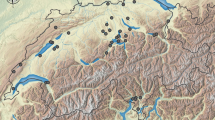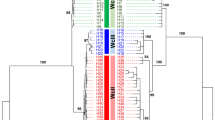Abstract
Despite being common in numerous marine bivalve lineages, lateral spines are extremely rare among freshwater bivalves (Bivalvia: Unionidae), with only three known species characterized by the presence of spines: Elliptio spinosa, Elliptio steinstansana, and Pleurobema collina. All three taxa are endemic to the Atlantic Slope of southeastern North America, critically endangered, and protected by the US Endangered Species Act. Currently, these species are recognized in two genera and remain a source of considerable taxonomic confusion. Because spines are rare in freshwater mussels and restricted to a small region of North America, we hypothesized that spinymussels represent a monophyletic group. We sequenced two mtDNA gene fragments (COI and ND1) and a fragment of the nuclear ITS-1 locus from >70 specimens. Bayesian and maximum-likelihood phylogenetic reconstructions suggest that the spinymussels do not comprise a monophyletic group. Elliptio steinstansana is sister to P. collina, forming a monophyletic clade that was estimated to have diverged from its most recent ancestor in the late Miocene and is distinct from both Elliptio and Pleurobema; we describe a new genus (Parvaspina gen. nov.) to reflect this relationship. Additionally, E. spinosa forms a monophyletic clade that diverged from members of the core Elliptio lineage in the mid-Pliocene. Furthermore, E. spinosa is genetically divergent from the other spinymussel species, suggesting that spines, while extremely rare in freshwater mussels worldwide, may have evolved independently in two bivalve lineages. Recognizing the genetic distinctiveness and inter-generic relationships of the spinymussels is an important first step towards effectively managing these imperiled species and lays the groundwork for future conservation genetics studies.





Similar content being viewed by others
References
Abell R, Thieme M, Revenga C, Bryer M, Kottelat M, Bogutskaya N, Coad B, Mandrak N, Balderas SC, Bussing W, Stiassny M, Skelton P, Allen G, Unmack P, Naseka A, Ng R, Sindorf N, Robertson J, Armijo E, Higgins J, Heibel T, Wikramanayake E, Olson D, Lopez H, Reis R, Lundberg J, Perez MS, Petry P (2008) Freshwater ecoregions of the world: a new map of biogeographic units for freshwater biodiversity conservation. Bioscience 58:403–414
Barnosky AD, Matzke N, Tomiya S, Wogan GOU, Swartz B, Quental TB, Marshall C, McGuire JL, Lindsey EL, Maguire KC, Mersey B, Ferrer EA (2011) Has the Earth’s sixth mass extinction already arrived? Nature 471:51–57
Bogan AE (2002) Workbook and key to the freshwater bivalves of North Carolina. North Carolina Museum of Natural Sciences, Raleigh, North Carolina
Bogan AE (2007) Global diversity of freshwater mussels (Mollusca, Bivalvia) in freshwater. Hydrobiologia 595:139–147
Bogan AE, Serb J, Lydeard C (2003) Determination of the systematic position and relationships of the Elliptio complex (Mollusca: Bivalvia: Unionidae) with distributions in North and South Carolina. Report submitted to USGS (Contract 01HQAG0185)
Boss KJ, Clench WJ (1967) Notes on Pleurobema collina (Conrad) from the James River, Virginia. Occasional Papers on Mollusks 3:45–52
Bottjer D, Carter J (1980) Functional and phylogenetic significance of projecting periostracal structures in the Bivalvia (Mollusca). J Paleontol 54:200–216
Buhay JE (2009) “COI-like” sequences are becoming problematic in molecular systematic and DNA barcoding studies. J Crustac Biol 29:96–110
Campbell D, Lydeard C (2012) The genera of Pleurobemini (Bivalvia: Unionidae: Ambleminae). Am Malacol Bull 30:19–38
Campbell DC, Serb JM, Buhay JE, Roe KJ, Minton RL, Lydeard C (2005) Phylogeny of North American amblemines (Bivalvia, Unionoida): prodigious polyphyly proves pervasive across genera. Invertebr Biol 124:131–164.
Campbell DC, Johnson PD, Williams JD, Rindsberg AK, Serb JM, Small KK, Lydeard C (2008) Identification of “extinct” freshwater mussel species using DNA barcoding. Mol Ecol Resour 8:711–724
Covich AP (2010) Winning the biodiversity arms race among freshwater gastropods: competition and coexistence through shell variability and predator avoidance. Hydrobiologia 653:191–215
Darriba D, Taboada GL, Doallo R, Posada D (2012) jModelTest 2: more models, new heuristics, and parallel computing. Nat Methods 9:772
Drummond AJ, Suchard MA, Xie D, Rambaut A (2012) Bayesian phylogenetics with BEAUti and the BEAST 1.7. Mol Biol Evol 29:1969–1973
Dudgeon D, Arthington AH, Gessner MO, Kawabata ZI, Knowler DJ, Lévêque C, Naiman RJ, Prieur-Richard AH, Soto D, Stiassny MLJ, Sullivan CA (2006) Freshwater biodiversity: importance, threats, status and conservation challenges. Biol Rev 81:163–182
Eads C, Levine J (2009) Propagation and culture of the Carolina heelsplitter (Lasmigona decorata) and Tar River spinymussel (Elliptio steinstansana). North Carolina Wildlife Resources Commission, Raleigh, North Carolina
Fleming WJ, Augspurger TP, Alderman JA (1995) Freshwater mussel die-off attributed to anticholinesterase poisoning. Environ Toxicol 14:877–879
Graf DL, Cummings KS (2007) Review of the systematics and global diversity of freshwater mussel species (Bivalvia: Unionoida). J Mollus Stud 73:291–314
Haag WR (2010) A heirarchical classification of freshwater mussel diversity in North America. J Biogeogr 37:12–26
Haag WR (2012) North American freshwater mussels: natural history, ecology, and conservation. Cambridge University Press, New York
Haag WR, Williams JD (2013) Biodiversity on the brink: an assessment of conservation strategies for North American freshwater mussels. Hydrobiologia 735:45–60
Hove MC, Neves RJ (1994) Life history of the endangered James spinymussel Pleurobema collina (Conrad, 1837) (Mollusca: Unionidae). Am Malacol Bull 11:29–40
Huelsenbeck JP, Ronquist F (2001) MRBAYES: Bayesian inference of phylogenetic trees. Bioinformatics 17:754–755
Humphries P, Winemiller KO (2009) Historical impacts on river fauna, shifting baselines, and challenges for restoration. Bioscience 59:673–684
Inoue K, Mcqueen AL, Harris JL, Berg DJ (2014) Molecular phylogenetics and morphological variation reveal recent speciation in freshwater mussels of the genera Arcidens and Arkansia (Bivalvia: Unionidae). Biol J Linn Soc 112:535–545
Johnson RI, Clark AH (1983) A new spiny mussel, Elliptio (Canthyria) steinstansana (Bivalvia: Unionidae), from the Tar River, North Carolina. Occasional Papers on Mollusks 4:289–298.
Johnson R, Boss KJ (1984) Fusconaia collina (Conrad), from the James River, Virginia, an additional note. Occasional Papers on Mollusks 5:319–320.
Johnson JA, Wisniewski JM, Fritts AK, Bringolf RB (2012a) Host identification and glochidia morphology of freshwater mussels from the Altamaha River basin. Southeastern Naturalist 11:733–746
Johnson PD, Bogan AE, Brown KM, Burkhead NM, Cordeiro JR, Garner JT, Hartfield PD, Lepitzki DAW, Mackie GL, Pip E, Tarpley TA, Tiemann JS, Whelan NV, Strong EE (2012b) Conservation status of freshwater gastropods of Canada and the United States. Fisheries 38:247–282
Jones JW, Neves RJ, Ahlstedt SA, Hallerman EM (2006) A holistic approach to taxonomic evaluation of two closely related endangered freshwater mussel species, the oyster mussel Epioblasma capsaeformis and tan riffleshell Epioblasma florentina alker (Bivalvia: Unionidae). J Molluscan Stud 72:267–283
King T, Eackles M, Gjetvaj B, Hoeh W (1999) Intraspecific phylogeography of Lasmigona subviridis (Bivalvia: Unionidae): conservation implications of range discontinuity. Mol Ecol 8:65–78
Larkin MA, Blackshields G, Brown NP, Chenna R, McGettigan PA, McWilliam H, Valentin F, Wallace IM, Wilm A, Lopez R, Thompson JD, Gibson TJ, Higgins DG (2007) Clustal W and Clustal X version 2.0. Bioinformatics 23:2947–2948
Levine J, Eads C, Greiner R, Bogan A (2011) Propagation and culture of federally listed freshwater mussel species. Prepared for the North Carolina Wildlife Resources Commission. Report: HWY-2009–16
Librado P, Rozas J (2009) DnaSP v5: A software for comprehensive analysis of DNA polymorphism data. Bioinformatics 25:1451–1452
Loreau M, Naeem S, Inchausti P, Bengtsson J, Grime JP, Hector A, Hooper DU, Huston M, Raffaelli D, Schmid B, Tilman D, Wardle D (2001) Biodiversity and ecosystem functioning: current knowledge and future challenges. Science 294:804–808
Marko PB (2002) Fossil calibration of molecular clocks and the divergence times of geminate species pairs separated by the Isthmus of Panama. Mol Biol Evol 19:2005–2021
McCormick MA (2012) Effects of small dams on freshwater bivalve assemblages in North Carolina piedmont and coastal plain streams. Thesis, Appalachian State University, Boone, North Carolina
Pereira HM, Leadley PW, Proença V, Alkemade R, Scharlemann JPW, Fernandez-Manjarrés JF, Araújo MB, Balvanera P, Biggs R, Cheung WWL, Chini L, Cooper HD, Gilman EL, Guénette S, Hurtt GC, Huntington HP, Mace GM, Oberdorff T, Revenga C, Rodrigues P, Scholes RJ, Sumaila UR, Walpole M (2010) Scenarios for global biodiversity in the 21st century. Science 330:1496–1501
Perkins MA, Gangloff MM (2015) Characterization of microsatellite loci in the Tar River and James River spinymussels (Elliptio steinstansana and Pleurobema collina). Report prepared for the North Carolina Wildlife Resources Commission, Raleigh, North Carolina
Petty MA (2005) Distribution, genetic characterization, and life history of the James spinymussel, Pleurobema collina (Bivalvia: Unionidae), in Virginia and North Carolina. Thesis, Virginia Polytechnic Institute and State University, Blacksburg, Virginia
Pfeiffer JM, Johnson NA, Randklev CR, Howells RG, Williams JD (2016) Generic reclassification and species boundaries in the rediscovered freshwater mussel ‘Quadrula’ mitchelli (Simpson in Dall, 1896). Conserv Genet 17:279–292
Rambaut A, Drummond AJ (2013) Tracer v1.6. http://beast.bio.ed.ac.uk/tracer
Sala OE (2000) Global biodiversity scenarios for the year 2100. Science 287:1770–1774
Sepkoski JJ, Rex MA (1974) Distribution of freshwater mussels: coastal rivers as biogeographic islands. Syst Biol 23:165–188
Serb JM, Buhay JE, Lydeard C (2003) Molecular systematics of the North American freshwater bivalve genus Quadrula (Unionidae: Ambleminae) based on mitochondrial ND1 sequences. Mol Phylogenet Evol 28:1–11
Simmons M, Ochoterena H (2000) Gaps as characters in sequence-based phylogenetic analyses. Syst Biol 49:369–381
Smith V (2003) Eutrophication of freshwater and coastal marine ecosystems: a global problem. Environ Sci Pollut Res Int 10:126–139
Stamatakis A (2014) RaxML version 8: a tool for phylogenetic analysis and post-analysis of large phylogenies. Bioinformatics 30:1312–1313
Stanley SM, Summer N (1981) Infaunal survival: alternative functions of shell ornamentation in the Bivalvia (Mollusca). Paleobiology 7:384–393
Stoeckle MY, Thaler DS (2014) DNA barcoding works in practice but not in (neutral) theory. PloS ONE 9:e100755.
Strayer DL, Dudgeon D (2010) Freshwater biodiversity conservation: recent progress and future challenges. J N Am Benthol Soc 29:344–358
Tamura K, Stecher G, Peterson D, Filipski A, Kumar S (2013) MEGA6: Molecular evolutionary genetics analysis version 6.0. Mol Biol Evol 30:2725–2729
Taylor HR, Harris WE (2012) An emergent science on the brink of irrelevance: a review of the past 8 years of DNA barcoding. Mol Ecol Res 12:377–388
Turgeon DD, Bogan AE, Coan EV, Emerson WK, Lyons WG, Pratt WL, Roper CFE, Scheltema A, Thompson FG, Williams JD (1998) Common and scientific names of aquatic invertebrates from the United States and Canada: Mollusks. American Fisheries Society Special Publication 16. American Fisheries Society, Bethesda
U.S. Fish and Wildlife Service (1985) Endangered and threatened wildlife and plants; final rule listing the Tar River spiny mussel (Elliptio (Canthyria) steinstansana) as an endangered species. Fed Regist 50:26572–26575
U.S. Fish and Wildlife Service (1988) Endangered and threatened wildlife and plants; determination of endangered status for the James spinymussel. Fed Regist 53:27689–27693
U.S. Fish and Wildlife Service (2008) James spinymussel (Pleurobema collina) 5-year review: summary and evaluation, USFWS Gloucester Field Office, Virginia
U.S. Fish and Wildlife Service (2009) Tar River spinymussel recovery action plan. http://ecos.fws.gov/docs/action_plans/doc3109.pdf
U.S. Fish and Wildlife Service (2011) Endangered status for the Altamaha spinymussel and designation of critical habitat; final rule. http://www.gpo.gov/fdsys/pkg/FR-2011-10-11/pdf/2011-25539.pdf
U.S. Fish and Wildlife Service (2014) Tar River spinymussel (Elliptio steinstansana) 5-year review: summary and evaluation. USFWS, Southeast Region, Raleigh Ecological Services Field Office, North Carolina
Watters GT (1994) Form and function of unionoidean shell sculpture and shape (Bivalvia). Am Malacol Bull 11:1–20
Williams JD, Bogan AE, Garner JT (2008) Freshwater mussels of Alabama and the Mobile basin in Georgia, Mississippi, and Tennessee. University of Alabama Press, Tuscaloosa, Alabama
Williams JD, Butler SB, Warren GL, Johnson NA (2014) Freshwater Mussels of Florida. University of Alabama Press, Tuscaloosa, Alabama
Wisniewski JM, Krakow G, Albanese B (2005) Current Status of endemic mussels in the lower Ocmulgee and Altamaha Rivers. In: Proceedings of the 2005 Georgia water resources conference, University of Georgia, Athens, Georgia
Acknowledgements
The authors would like to thank Rachael Hoch, Jess Jones, Rob Nichols, William Russ, Lynn Siefferman, Jim Williams, and Jason Wisniewski for their assistance with sample collection and/or comments during the preparation of this manuscript. This research was funded in part by the U.S. Fish and Wildlife Service, North Carolina Wildlife Resources Commission, and the U.S. Geological Survey. Any use of trade, firm, or product names is for descriptive purposes only and does not imply endorsement by the U.S. Government.
Author information
Authors and Affiliations
Corresponding author
Electronic supplementary material
Below is the link to the electronic supplementary material.
Rights and permissions
About this article
Cite this article
Perkins, M.A., Johnson, N.A. & Gangloff, M.M. Molecular systematics of the critically-endangered North American spinymussels (Unionidae: Elliptio and Pleurobema) and description of Parvaspina gen. nov.. Conserv Genet 18, 745–757 (2017). https://doi.org/10.1007/s10592-017-0924-z
Received:
Accepted:
Published:
Issue Date:
DOI: https://doi.org/10.1007/s10592-017-0924-z




